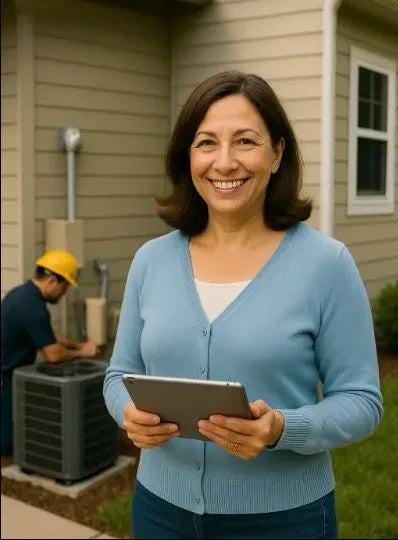Your Pre-Purchase Checklist for R-32 AC + Gas Furnace Systems
Why You Need a Checklist Before Buying
Investing in a new HVAC system isn’t something homeowners do often—but when the time comes, it’s a big decision. With the rise of R-32 refrigerant systems, homeowners now face new efficiency standards, refrigerant regulations, and product options that weren’t on the table just five years ago.
A buyer’s checklist helps you avoid costly mistakes. From sizing and efficiency ratings to rebates and installation quality, knowing the right questions to ask ensures you pick the right R-32 AC + gas furnace system for your home and budget.
Section 1: Understand the Refrigerant Shift (R-32 vs R-410A)
The first thing to know: your new system will likely use R-32 refrigerant.
-
Lower GWP: R-32 has a Global Warming Potential (GWP) of 675, much lower than R-410A’s 2,088 (Daikin Global).
-
Efficiency boost: It allows for higher SEER2 ratings without oversized coils.
-
Regulatory alignment: The EPA’s AIM Act is phasing down R-410A nationwide.
Checklist item: Ask your contractor:
-
Is this system built for R-32?
-
Will it remain compliant with refrigerant regulations through 2036?
Section 2: Sizing Your System Correctly
An HVAC system that’s too small will constantly run, while one that’s too large will cycle inefficiently. Both scenarios waste energy and shorten system life.
-
Load calculation (Manual J): Your contractor should size the system based on square footage, insulation, and climate.
-
Tonnage match: Typical homes range from 2–5 tons for AC systems.
-
Furnace BTUs: Look for 80,000–100,000 BTUs for medium to large homes, adjusted by region.
Checklist item: Request a written load calculation—not just a guess based on square footage.
Section 3: Efficiency Ratings (SEER2 & AFUE)
Efficiency determines your long-term costs.
-
SEER2 (Seasonal Energy Efficiency Ratio 2): Higher is better. Entry-level R-32 ACs start at 14.4 SEER2; premium systems reach 22–24 SEER2.
-
AFUE (Annual Fuel Utilization Efficiency): Gas furnaces range from 80% (standard) to 98% (ultra-high efficiency).
-
Energy Star certification: Look for systems that qualify for rebates. Energy Star maintains updated lists of qualified systems.
Checklist item: Compare SEER2 and AFUE ratings across at least two brands.
Section 4: Installation Quality Matters
Even the best system can fail if installed poorly. Studies show improper installation can cut efficiency by up to 30%.
What to verify:
-
Licensed contractor credentials.
-
Proper refrigerant charge and airflow testing.
-
Matching components (AC, furnace, and thermostat).
Checklist item: Ask your installer for post-installation testing reports.
Section 5: Warranty Coverage & Support
Warranties differ dramatically between brands.
-
Goodman: 10-year limited parts.
-
Amana: Lifetime unit replacement warranty on select compressors.
-
Carrier/Trane/Lennox: 10-year parts, sometimes labor included.
Checklist item: Confirm if the warranty covers parts, labor, and compressor replacement.
Section 6: Rebates, Tax Credits & Incentives
2025 is a golden year for HVAC incentives.
-
Federal Tax Credit: Up to $2,000 via the Inflation Reduction Act.
-
State Programs: Many states offer rebates for high-efficiency gas furnaces and ACs.
-
Utility Rebates: Local power companies often provide $500–$1,500 back.
Check Energy.gov’s tax credit guide for the latest rebates.
Checklist item: Ask your contractor which incentives apply in your ZIP code.
Section 7: Noise Levels & Comfort Features
HVAC systems aren’t just about temperature—they’re about comfort.
-
Variable-speed compressors maintain steadier temps.
-
Quiet operation: Premium systems run at <55 dB, compared to 70+ dB for older units.
-
Humidity control: Some R-32 systems improve indoor air quality with dehumidification.
Checklist item: Ask for decibel ratings and comfort features before purchase.
Section 8: Smart Controls & Integration
Today’s systems often come with app-based monitoring and smart thermostat integration.
-
Carrier’s Infinity Control and Lennox’s iComfort® provide advanced zoning and diagnostics.
-
Many models pair seamlessly with Google Nest or Amazon Alexa.
Checklist item: Confirm compatibility with your smart home setup.
Section 9: Brand Comparisons to Consider
Every homeowner’s checklist should include a side-by-side brand review:
| Brand | Price Tier | SEER2 Range | AFUE Range | Notable Feature |
|---|---|---|---|---|
| Goodman | $ | 14.4–15.2 | 80–96% | Budget-friendly |
| Amana | $$–$$$ | 15–20 | 80–98% | Lifetime warranty |
| Carrier | $$$ | 16–20 | 80–96% | Infinity controls |
| Trane/AS | $$$ | 16–22 | 80–97% | Durability |
| Rheem/Ruud | $$ | 15–17 | 80–96% | EcoNet smart controls |
| Lennox | $$$$ | 18–24 | 80–98% | Quietest operation |
Section 10: The Final Pre-Purchase Checklist
Before signing a contract, confirm you’ve checked these 10 essentials:
-
✅ R-32 refrigerant system for future compliance.
-
✅ Load calculation (Manual J) performed.
-
✅ SEER2 and AFUE efficiency ratings compared.
-
✅ Licensed contractor with references.
-
✅ Post-installation testing included.
-
✅ Warranty coverage (parts + labor).
-
✅ Rebates and tax credits applied.
-
✅ Noise level and comfort features verified.
-
✅ Smart thermostat compatibility.
-
✅ Brand comparison aligned with your budget and goals.
Buy Smarter, Not Just Faster
Purchasing a new R-32 AC + gas furnace system is one of the largest home investments you’ll make in 2025. With this buyer’s checklist in hand, you’ll not only ensure compliance with new refrigerant regulations—you’ll maximize comfort, minimize operating costs, and secure the right protections for years to come.
A little extra due diligence now means you’ll enjoy peace of mind later.







